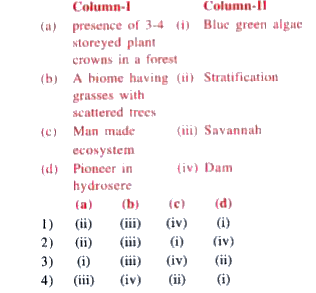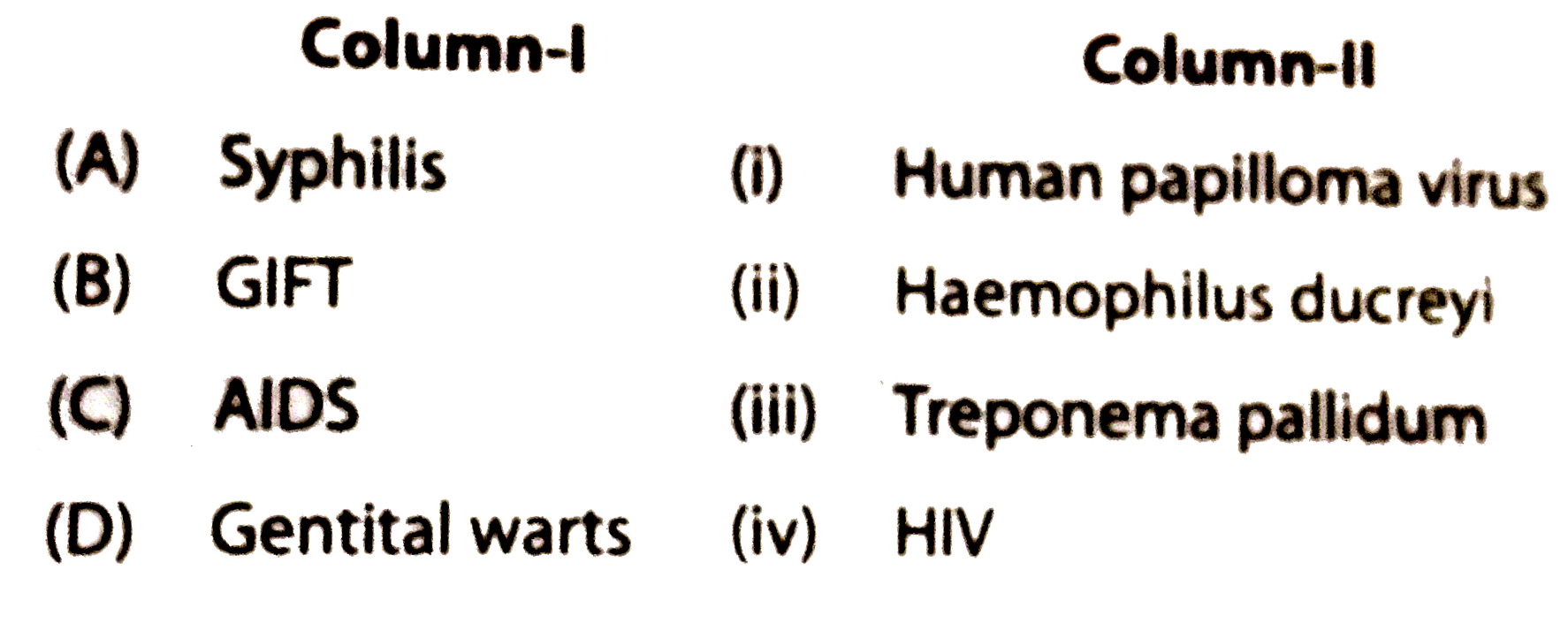Match the locomotor given under Column - I with the group listed under Column - II and select the correct option from the codes given below .
Column−I(Locomotor organs)Column−II(Group)(a)Pseudopotia(i)Mollusca(b)Comb plates (ii)Chondrichthyes(c)Foot(iii)Protozoa(d)Fins(iv)Ctenophora
(a)(b)(c)(d)(iii)(i)(iv)(ii)
(a)(b)(c)(d)(i)(iii)(iv)(i)
(a)(b)(c)(d)(iv)(iii)(ii)(i)
(a)(b)(c)(d)(iii)(iv)(i)(ii)
The correct Answer is:D
To solve the question of matching locomotor organs from Column-I with the corresponding groups in Column-II, we can follow these steps:
1. Identify the Locomotor Organ for Each Entry in Column-I:
- (a) Pseudopodia: This is a temporary protrusion of the cytoplasm used for locomotion and feeding, primarily found in Protozoa.
- (b) Comb plates: These are structures used for locomotion in Ctenophora (commonly known as comb jellies).
- (c) Foot: The foot is a muscular structure used for locomotion in Mollusca (such as snails and clams).
- (d) Fins: Fins are the primary locomotor organs in Chondrichthyes (which includes sharks and rays).
2. Match Each Locomotor Organ with the Correct Group:
- (a) Pseudopodia → (iii) Protozoa
- (b) Comb plates → (iv) Ctenophora
- (c) Foot → (i) Mollusca
- (d) Fins → (ii) Chondrichthyes
3. Compile the Matches:
- A → iii
- B → iv
- C → i
- D → ii
4. Select the Correct Option from the Given Codes:
- Now, we need to find the option that matches these pairs:
- A (Pseudopodia) matches with (iii) Protozoa
- B (Comb plates) matches with (iv) Ctenophora
- C (Foot) matches with (i) Mollusca
- D (Fins) matches with (ii) Chondrichthyes
5. Evaluate the Options:
- The correct matching is:
- A → iii
- B → iv
- C → i
- D → ii
- This corresponds to Option 4.
Final Answer:
The correct option is Option 4.
- (a) Pseudopodia: This is a temporary protrusion of the cytoplasm used for locomotion and feeding, primarily found in Protozoa.
- (b) Comb plates: These are structures used for locomotion in Ctenophora (commonly known as comb jellies).
- (c) Foot: The foot is a muscular structure used for locomotion in Mollusca (such as snails and clams).
- (d) Fins: Fins are the primary locomotor organs in Chondrichthyes (which includes sharks and rays).
- (a) Pseudopodia → (iii) Protozoa
- (b) Comb plates → (iv) Ctenophora
- (c) Foot → (i) Mollusca
- (d) Fins → (ii) Chondrichthyes
- A → iii
- B → iv
- C → i
- D → ii
- Now, we need to find the option that matches these pairs:
- A (Pseudopodia) matches with (iii) Protozoa
- B (Comb plates) matches with (iv) Ctenophora
- C (Foot) matches with (i) Mollusca
- D (Fins) matches with (ii) Chondrichthyes
- The correct matching is:
- A → iii
- B → iv
- C → i
- D → ii
- This corresponds to Option 4.
The correct option is Option 4.
Topper's Solved these Questions
- BOOK - AAKASH SERIESCHAPTER - ANIMAL KINGDOM EXERCISE - EXERCISE -II (PISCES)14videos
ANIMAL KINGDOM
- BOOK - AAKASH SERIESCHAPTER - ANIMAL KINGDOM EXERCISE - EXERCISE -II (REPTILIA)12videos
ANIMAL KINGDOM
- BOOK - AAKASH SERIESCHAPTER - ANIMAL KINGDOM EXERCISE - EXERCISE -II (NONCHORDATES)41videos
ANIMAL KINGDOM
- BOOK - AAKASH SERIESCHAPTER - BIODIVERSITY AND CONSERVATIONEXERCISE - EXERCISE-II India - A major Source of Biodiversity and its Preservation2videos
BIODIVERSITY AND CONSERVATION
Similar Questions
Match Column - I with Column -II and select the correct option from the codes given below .
 View Solution
View SolutionMatch the items given in Column - I with those in Column - II and select the correct option from the codes given below .
 View Solution
View SolutionMatch Column-I with Column-II and select the correct option from the codes given below.
 View Solution
View SolutionMatch Column-I with Column-II and select the correct option from the codes given below.
 View Solution
View SolutionMatch Column-I with Column-II and select the correct option from the codes given below.
 View Solution
View SolutionMatch column I with column II and select the correct option from the codes given below .
 View Solution
View SolutionMatch Column-I with Column-II and select the correct option from the codes given below.
 View Solution
View SolutionMatch Column-I with Column-II and select the correct option from the codes given below.
 View Solution
View SolutionMatch Column-I with Column-II and select the correct option from the codes given below.
 View Solution
View SolutionMatch Column-I with Column-II and select the correct option from the codes given below.
 View Solution
View Solution
